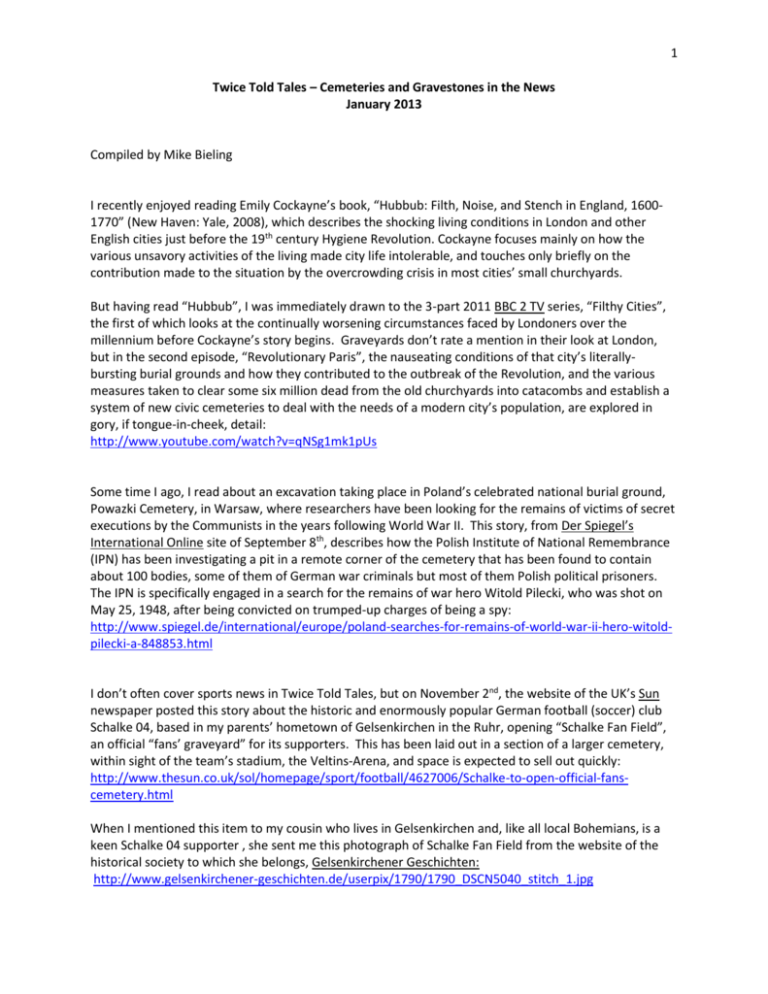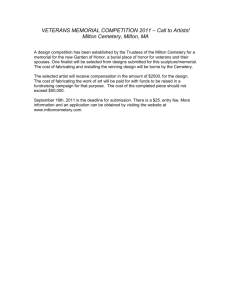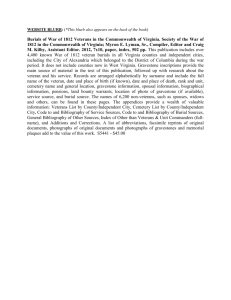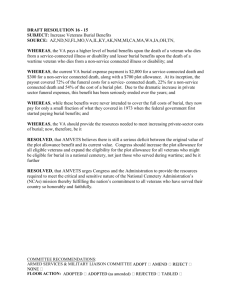JA13-Twice - Association for Gravestone Studies
advertisement

1 Twice Told Tales – Cemeteries and Gravestones in the News January 2013 Compiled by Mike Bieling I recently enjoyed reading Emily Cockayne’s book, “Hubbub: Filth, Noise, and Stench in England, 16001770” (New Haven: Yale, 2008), which describes the shocking living conditions in London and other English cities just before the 19th century Hygiene Revolution. Cockayne focuses mainly on how the various unsavory activities of the living made city life intolerable, and touches only briefly on the contribution made to the situation by the overcrowding crisis in most cities’ small churchyards. But having read “Hubbub”, I was immediately drawn to the 3-part 2011 BBC 2 TV series, “Filthy Cities”, the first of which looks at the continually worsening circumstances faced by Londoners over the millennium before Cockayne’s story begins. Graveyards don’t rate a mention in their look at London, but in the second episode, “Revolutionary Paris”, the nauseating conditions of that city’s literallybursting burial grounds and how they contributed to the outbreak of the Revolution, and the various measures taken to clear some six million dead from the old churchyards into catacombs and establish a system of new civic cemeteries to deal with the needs of a modern city’s population, are explored in gory, if tongue-in-cheek, detail: http://www.youtube.com/watch?v=qNSg1mk1pUs Some time I ago, I read about an excavation taking place in Poland’s celebrated national burial ground, Powazki Cemetery, in Warsaw, where researchers have been looking for the remains of victims of secret executions by the Communists in the years following World War II. This story, from Der Spiegel’s International Online site of September 8th, describes how the Polish Institute of National Remembrance (IPN) has been investigating a pit in a remote corner of the cemetery that has been found to contain about 100 bodies, some of them of German war criminals but most of them Polish political prisoners. The IPN is specifically engaged in a search for the remains of war hero Witold Pilecki, who was shot on May 25, 1948, after being convicted on trumped-up charges of being a spy: http://www.spiegel.de/international/europe/poland-searches-for-remains-of-world-war-ii-hero-witoldpilecki-a-848853.html I don’t often cover sports news in Twice Told Tales, but on November 2nd, the website of the UK’s Sun newspaper posted this story about the historic and enormously popular German football (soccer) club Schalke 04, based in my parents’ hometown of Gelsenkirchen in the Ruhr, opening “Schalke Fan Field”, an official “fans’ graveyard” for its supporters. This has been laid out in a section of a larger cemetery, within sight of the team’s stadium, the Veltins-Arena, and space is expected to sell out quickly: http://www.thesun.co.uk/sol/homepage/sport/football/4627006/Schalke-to-open-official-fanscemetery.html When I mentioned this item to my cousin who lives in Gelsenkirchen and, like all local Bohemians, is a keen Schalke 04 supporter , she sent me this photograph of Schalke Fan Field from the website of the historical society to which she belongs, Gelsenkirchener Geschichten: http://www.gelsenkirchener-geschichten.de/userpix/1790/1790_DSCN5040_stitch_1.jpg 2 “Schalke Fan Field” Cemetery, Gelsenkirchen, Germany, 2012 Photo: Gelsenkirchener Geschichten The Sunstar website of Cebu City, the Philippines, ran a story on November 3rd reporting on the current business outlook for gravestone carvers as more continue to enter an already-competitive market there. The two-month training period mentioned and the physical description of the standard marker makes it fairly clear that they’re talking about basic inscribed in-ground plaques: http://www.sunstar.com.ph/cebu/business/2012/11/03/more-persons-take-craft-gravestone-makerssee-flat-sales-251424 Another story from the Philippines a few days earlier looked at a different type of cemetery-related entrepreneur, the caretaker of celebrity graves. The website of the Philippine Daily Inquirer of November 1st posted an interview with Milagros Moncada, about her 30 years of making a good living maintaining 25 mausoleums of famous families in Manila’s Memorial Park in Sucat: http://newsinfo.inquirer.net/299430/caretakers-of-celebrities-graves-earn-good-living The use of QR (Quick Response) codes on gravestones, allowing visitors with smartphones to download information about the deceased beyond that offered by the inscription, is a technology that continues to catch on. My son sent me this link to the BBC News North East Wales website for a story posted on January 2nd about the installation of QR codes on the gravemarkers for 80 Canadian servicemen and women buried at St Margaret's Church, Bodelwyddan, in Wales, near Kinmel Camp, where 17,000 Canadians were stationed after the end of World War I. Most of the war dead here perished during the influenza pandemic of 1918-1919, though a few died during a mutinous riot in March, 1919, when the Canadians discovered that troop ships that had been assigned to take them home had been diverted to return Americans, many of whom had never seen action: http://www.bbc.co.uk/news/uk-wales-north-east-wales-20881406 A friend of my Facebook friend Robin Ireland read a comment I made about our cemetery work remembering veterans and sent me this link to a story from the October 2012 issue of American Woodturner, the journal of the American Association of Woodturners. It describes a worthwhile project undertaken by the Adirondack Woodturners' Association and the Northeastern Woodworkers' Association Crafters of New York State to produce hand-crafted wooden urns for the Patriot Guard Riders, a national organization of motorcycle enthusiasts formed to oppose the Westboro Baptist 3 Church's disgraceful demonstrations at military and other funerals, and who themselves attend funerals to honor fallen US military personnel. The PGR is also dedicated to helping locate and identify the roughly 100,000 sets of unclaimed cremains being stored in mortuaries across the USA, and if they are of veterans, to arranging for a military funeral and burial in a national cemetery. The author mentions how important a reliable supply of urns is to such projects, and includes illustrations and instructions for making them. Click on "Click to Read", then scroll across the bottom to pages 22-23 and click again. You can zoom in and out by clicking on those pages. http://issuu.com/aawwebmaster/docs/2012_oct As I was writing my comments on the wood turners’ project, I came upon a related report that, amidst all of the year-end foot-dragging over a resolution to the “fiscal cliff” crisis, on December 31st, the US House and Senate had both passed the “Dignified Burial of Veterans Act of 2012”. As described in this story posted on January 2nd on the website of KCEN-TV, of Waco, Texas, this legislation authorizes the US Department of Veterans’ Affairs to furnish a casket or urn for veterans with no known next of kin to provide one, before burial in a national cemetery. No more cardboard box interments. This story mentions how the Central Texas Patriot Guard Riders have been involved in these activities and have organized funerals and acted as family for several homeless veterans in their region: http://www.kcentv.com/story/20488919/congress-passes More complete details about the “Dignified Burial of Veterans Act of 2012” are available in this press release from the US Senate Committee on Veterans’ Affairs: http://veterans.senate.gov/press-releases.cfm?action=release.display&release_id=2cb75427-39114a1e-a16a-85c0b1b05270 And in another story regarding veterans’ burials, AGS member Luann Waters, who bears the intriguing titles of “State Coordinator, Oklahoma Leopold Education Project, Conservation & History Educator, Dutch Oven Cooking Instructor”, sent along some kind remarks about Twice Told Tales recently and asked whether I was aware the joint initiative by the Department of Veterans’ Affairs and Ancestry.com, the genealogy website, to digitize veterans’ burial records and make them accessible to researchers and Ancestry.com subscribers. Ancestry.com is assembling digitized records from several sources into a new collection, the "U.S. Burial Registers, Military Posts and National Cemeteries, 1862-1960", which was posted on their website on Veterans’ Day, 2012. Luann forwarded this link to an article about this project, posted on the website of the Wayne County, Missouri, Journal Banner on January 14th: http://www.waynecojournalbanner.com/news/article_f17de58e-5e6b-11e2-8576-0019bb30f31a.html In stark contrast to efforts to offer impoverished veterans a dignified burial, a television news story on January 10th brought us this tale of wretched excess, about the Catacombo Sound System, lately being marketed by the Swedish firm of Pause Ljud & Bild, in Stockholm. This $30,000 system consists of an online music playlist management application, a music server with 4G connection, 7 inch LCD display and amplifier built into a headstone, and a top quality American-style casket fitted with two amplifiers and four speakers. I found an item about this at the December 15th website of The Scotsman: http://www.scotsman.com/news/odd/don-t-rest-in-peace-get-music-in-your-coffin-1-2693331 Trying to understand this story led me to the website of the manufacturers themselves, but that still didn’t answer the question, “why?”: http://catacombosoundsystem.com/ 4 On January 18th, Britain’s Daily Mail on-line brought us that day’s story about Ned Kelly, Australia's most notorious outlaw and controversial folk hero, finally getting the dignified funeral he wanted, 132 years after his hanging for killing three police officers: http://www.dailymail.co.uk/news/article-2264358/Ned-Kellys-final-farewell-Headless-outlaw-getsdead-mans-wish-Catholic-memorial.html The following story was posted on the Australian Border Mail’s website on January 18th, also about the funeral for bushranger Ned Kelly. Though less substantial than the Daily Mail piece above, it includes a video and set of photos of the event. Of interest to hearse aficionados will be several shots of a righthand-drive Chrysler 300 hearse of an unusual gull-wing design, which was used for the service. This takes the English convention of hearses having large single-pane glass side windows – the better to show off the coffin one's family has had to pay for – and extends it to having the entire casket table covered by a glass clamshell hinged on a longitudinal rib. http://www.bordermail.com.au/story/1243600/ned-kelly-funeral-most-significant-historical-day/?cs=55 Mike Bieling lives in Duncan, B.C., and can be reached at oldcemeterian@shaw.ca







